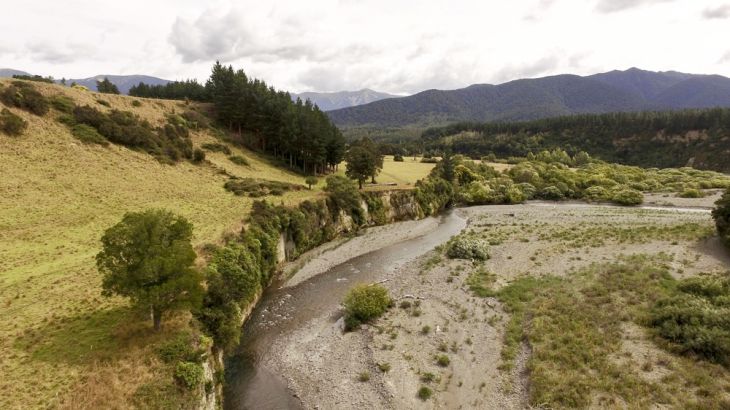What is the problem with New Zealand’s water sources?
A look at how water pollution has become a major concern for the country

Pristine waters and untouched islands are synonymous with New Zealand, drawing international and domestic travellers by the millions, annually.
According to the Ministry of Business, Innovation and Employment, tourism is one of New Zealand’s largest sources of revenue, with a direct GDP contribution of $12.9bn (or 5.6 percent). It is also responsible for 7.5 percent of total employment in New Zealand (in the year ending March 2016).
Keep reading
list of 4 itemsWorld’s coral reefs face global bleaching crisis
Why is Germany maintaining economic ties with China?
Australia’s Great Barrier Reef suffers worst bleaching on record
Dairy and agriculture are also major contributors to New Zealand’s GDP, and there has been significant growth in both industries. Dairy is also New Zealand’s largest export goods sector, accounting for more than one in four goods export dollars coming into New Zealand.
![New Zealand's fresh water bodies are under pressure from increased agriculture and dairy activities [Al Jazeera]](/wp-content/uploads/2017/08/233b64e5d9c9430896c1ab0570948ee4_18.jpeg)
But as the dairy and agriculture industries grow, they are placing an ever-greater strain on the country’s water supply and raising concerns about the quality of New Zealand’s water.
In August 2016, more than 5,000 people fell sick with gastrointestinal illness in Havelock North, a suburb of New Zealand’s North Island’s Hawke’s Bay district. The suburb’s drinking water had become contaminated, resulting in the poisoning of a third of its population and contributing to the deaths of three residents.
The incident shook the public’s confidence in the safety of New Zealand’s drinking water, and led to an investigation by the Department of Internal Affairs.
But what exactly is tainting the quality of New Zealand’s fresh water supplies and could a potential solution have a knock-on effect on all of New Zealand’s main economic contributors?
![Questions regarding the safety of New Zealand's water supplies are more prominent after pollution-related hospitalisations [Al Jazeera]](/wp-content/uploads/2017/08/f4b99f11823d4ebfaa906ee916f7f1fd_18.jpeg)
What are the main causes of water pollution in New Zealand?
Urbanisation, the drainage of wetlands and the damming or modification of rivers, have all placed pressure on fresh water bodies around the country.
However, according to the Ministry for the Environment, land use and population growth are the main factors affecting the health of New Zealand’s fresh water.
Farmland’s contribution to the economy and the need to provide for a growing population are both factors in the concentrated efforts to expand New Zealand’s agriculture and dairy industries.
New Zealand boasts one of the world’s highest rates of agricultural land intensification.
Between 1990 and 2012 alone, the estimated amount of nitrogen leached from agricultural land increased by 29 percent.
![Nitrate levels in New Zealand's fresh water supplies [Al Jazeera]](/wp-content/uploads/2017/08/5012ac7c24964832b86afa9dc2d216af_6.jpeg)
Nitrogen and phosphorus are the two nutrients causing the most concern. These nutrients occur naturally in water sources, but, in high concentrations, are known to create inhospitable environments for plant and animal species. High nitrate-nitrogen concentrations can also make water unsafe to drink and nitrate-nitrogen concentration is 18 times higher in urban sites compared with native sites.
An estimated 137 million kilogrammes of nitrogen were found in tested soil in 2012.
New Zealand also faces an increase in E coli, or Escherichia coli, in fresh water sources as a result of the growth in farmland.
E coli is a group of bacteria usually found in the intestines of mammals and is, therefore, present in New Zealand’s rivers through the leaching of livestock faecal matter into nearby water sources.
Swimming in water infected with the bacteria puts the swimmer at risk.
High concentrations of E coli are also associated with Campylobacter (a gastrointestinal illness).
What is being done to resolve New Zealand’s water pollution crisis?
A number of solutions have been put in place to alleviate the pressure placed on New Zealand’s fresh water. The Clean Water Package set the target of making 90 percent of New Zealand’s rivers and lakes swimmable by 2040. Clean-up and protection projects are in place across the country.
Economy-focused solutions have also been proposed, such as the controversial Ruataniwha water storage scheme, a dam pitched as a long-term sustainable water supply solution for Central Hawke’s Bay.
The dam had a 600 million New Zealand dollar ($432.5m) price tag and it promised farmers opportunities to diversify into other types of land use (dairy, horticulture and crops) and was forecast to increase annual regional GDP by a minimum of 130 million New Zealand dollars ($98m) and to create more than 1,000 new jobs.
![Pros and cons of the proposed Ruataniwha dam [Al Jazeera]](/wp-content/uploads/2017/08/2fa72bc624f34eddbc285644d6c9e3b6_6.jpeg)
However, independent conservation organisations like Forest and Bird strongly opposed the project, posing environmental risks as a major concern. The environmental risk assessment was deemed close to obsolete before the scheme was completed, with factors too difficult to quantify.
The parties opposed to the scheme pointed to fears that an increased number of farms could lead to fertiliser and cow-urine deposits into the Tukituki River – home to declining numbers of freshwater fish species – and a forecast that parts of the river may flood.
The Hawke’s Bay Regional Council decided to pull all financial support from the project this week, writing off millions of dollars already spent on planning and resources.
![The environmental impact of proposed irrigation schemes are currently being revised by the New Zealand government [Al Jazeera]](/wp-content/uploads/2017/08/98308f0977664e10b7ac5783bf55388f_18.jpeg)